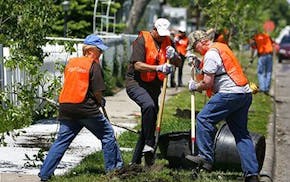Two Minnesota State Fair prizewinning white bunnies huddle next to each other on a black felt surface. A horizontal stripe cuts through the middle of the bronze print. The very tips of the bunnies' ears poke into that rich, blood-red strip.
In another image, two "best" geese stand tall, their necks pointing upward. Red stripes streak down the print. In nature, the geese would never stand together like this. But captured here, they are together briefly, like two people who've met momentarily at a speed dating event, likely never to see each other again.
These are just a few of the animal subjects in artist R.J. Kern's 16-photo series "The Best of the Best," on view at Burnet Fine Art & Advisory in Wayzata through Aug. 31, concurrent with much of this year's State Fair, which ends Sept. 2.
Kern is best known for his work photographing domesticated farm animals, glorifying them as if they were royalty.
Last year, as the State Fair's Official Commemorative Artist — the first photographer to have the role — Kern had special access to the "best" animals and made their portraits using a 19th-century bronze-tinted salt photo technique.
"When he photographs them, they become significant portraits, almost like archetypes," said Deborah Ultan, curator at the Gorman Rare Art Book Collection at the University of Minnesota. "R.J. bridges the history of photography with the present, and I think he beautifully does that in a way that is so seamless that you feel like you're looking at something old and new at the same time. "
Animal contests and photography
American animal contests and photography both began around 1840, making for the historical and conceptual underpinning for Kern's series. The first state fair was held in upstate New York in 1841, and it was there that animal exhibitions began. At the same time in France, the Parisian trio known as Nadar became known for its early portrait photography.
In Kern's work, where he explores domesticated animals, every element has a meaning.
"A lot of people don't put 2+2 together, but that red is a unifying element," Kern said. "And salt is a component — it is the largest element in blood, like water."
His art-making can seem obsessive, much like livestock judging, where astute attention is paid to every detail of the animals' bodies, ultimately deciding what is "perfect."
"The judges are looking at the development of the mammary glands, musculature, size of teats — the anatomical structure," Kern said. "It's no different from a bodybuilding contest or a beauty contest — it's a very subjective thing, trying to articulate why they are choosing one thing or the other."
At the same time, thanks to science and genetic modification, animals today aren't quite like they were 150 years ago. But not even science can ensure that the "best" animal is created by mating two supreme champions, male and female.
Kern experienced intentional breeding failures firsthand.
For many years, he and his wife, Krista, a Minnesota native, had a golden doodle named Willie. He was supposed to neither bark nor shed, but the breeder didn't take into account recessive genetics and their unintended consequences.
"Willie barked and shed," Kern said.
Minnesota home
Kern's fascination with domesticated animals began when he came to Minnesota in 2011, after meeting Krista. They live near Lake Harriet in south Minneapolis with their two children, ages 3 and 4.
Born in upstate New York, Kern had a nomadic childhood. His dad was in the military, and he grew up in Virginia, North Carolina and Seattle, where he discovered photography. After getting his undergraduate degree from Colgate University in upstate New York, he moved to Colorado to earn a master's in geography. He had a five-year stint at National Geographic as a cartographer.
In Minnesota, his inspiration took him out to the pasture, partly inspired by his wife's small town upbringing. She's from the kind of place where everyone knows your name.
"I wish I had that," he said of Krista's background. "There is a little bit of longing for that, I think."
For his 2017 series "The Unchosen Ones," Kern photographed animals entered into competitions with their young owners — selecting the ones that didn't make the cut in county fairs. He cites empathy as a driving element of the project.
"I think we all know what it's like to not be chosen for something," he said.
His focus on photographing domestic animals is also weirdly informed by his former career as a wedding photographer.
"There are expectations on a wedding day. Everyone wants to feel beautiful," he said. He also had to meet the expectations of paying clients, often the mother of the bride.
In capturing images of the animals, he has total control over how they are portrayed, without the demands of onlookers or clients. Yet in both roles, he is coming up with images of "perfection" — the perfect wedding day, the glorified and winning domestic farm animal.
Fellow photographer, friend and sometimes mentor Stuart Klipper, who is known for his striking panoramic photographs of Antarctica, first happened upon Kern's early series "The Sheep and the Goats" at Gallery 360 in Minneapolis.
For that project, Kern returned to his ancestral homelands of Germany, Ireland, Norway and Iceland, shooting portraits of sheep and goats in idealized natural scenes, much like those found in old master and European landscape paintings. He was particularly keen on the use of light in these photos.
"Photography is painting with light," Kern said.
"They had a transcendency," Klipper said. "He is very sharp, and he doesn't come to things without — in the best possible sense — a good deal of baggage."

Yuen: Why do people forgive? It's messy, complex and 'the best form of self-interest'

Hark, downtown Minneapolis' only vegan, gluten-free cafe, closing April 28

Critics' picks: The 12 best things to do and see in the Twin Cities this week
How the Goo Goo Dolls learned the music biz from Minneapolis bands

